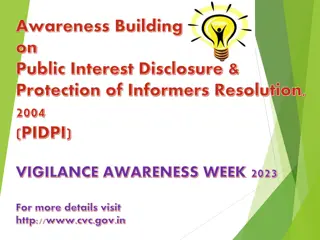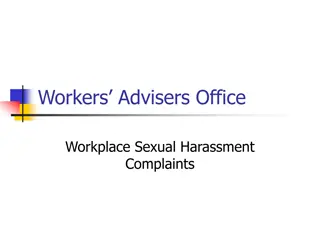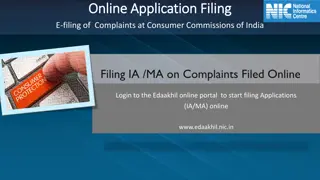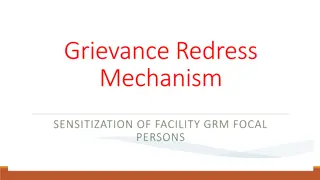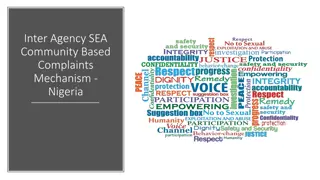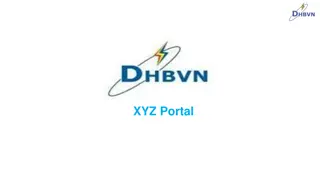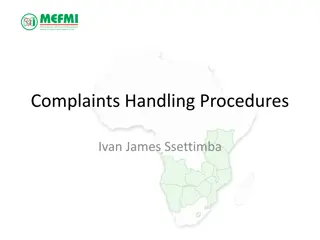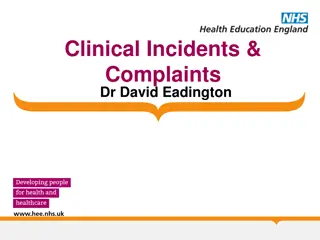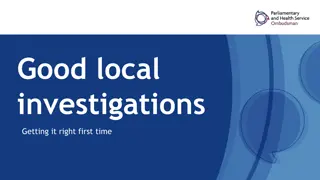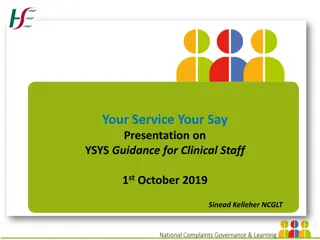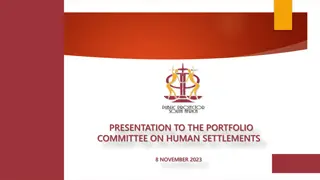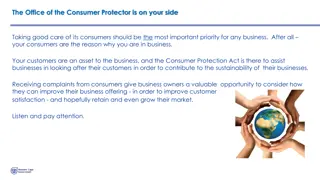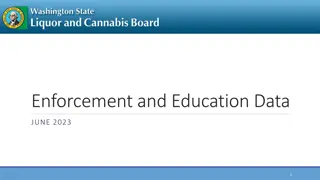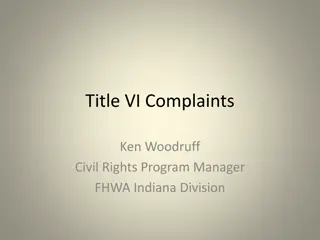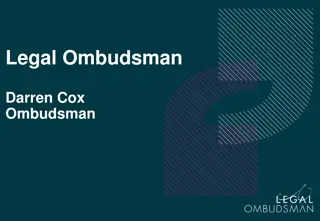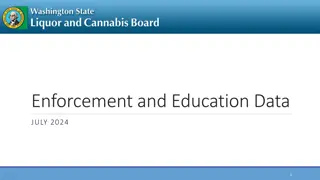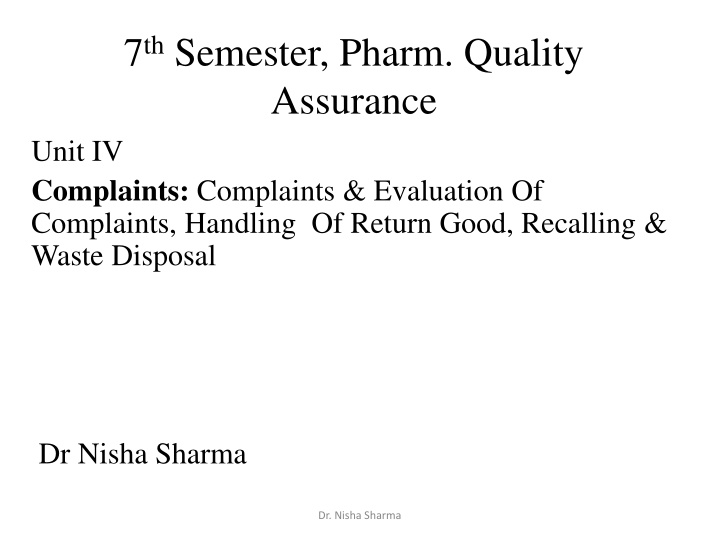
Quality Assurance in Pharmaceutical Industry: Handling Complaints and Evaluations
Learn about the importance of managing complaints in the pharmaceutical industry, including types of complaints, sources, and ways to handle various issues effectively. Gain insights into the evaluation, handling of returns, recalling products, and waste disposal procedures to maintain quality standards.
Download Presentation

Please find below an Image/Link to download the presentation.
The content on the website is provided AS IS for your information and personal use only. It may not be sold, licensed, or shared on other websites without obtaining consent from the author. If you encounter any issues during the download, it is possible that the publisher has removed the file from their server.
You are allowed to download the files provided on this website for personal or commercial use, subject to the condition that they are used lawfully. All files are the property of their respective owners.
The content on the website is provided AS IS for your information and personal use only. It may not be sold, licensed, or shared on other websites without obtaining consent from the author.
E N D
Presentation Transcript
7thSemester, Pharm. Quality Assurance Unit IV Complaints: Complaints & Evaluation Of Complaints, Handling Of Return Good, Recalling & Waste Disposal Dr Nisha Sharma Dr. Nisha Sharma
INTRODUCTION: COMPLAINTS Definition: A statement that says something is unsatisfactory or unacceptable about the product/ packaging in terms of any defect in Pharmaceutical product May be received from Pharmacists, Physicians, wholesalers, Retailers, Patients. Therefore, as per GMP, Industry has their own procedures to maintain records, investigation and review steps of complaints & accordingly a system to recall the product from the market. Dr. Nisha Sharma
Types of complaints TYPE A Critical TYPE B Major TYPE C Minor Adverse drug reactions Major health issues Safety & purity Product Stability issues Potency of product Issues related to labeling or coding of batch details Secondary packaging material problems etc Issues related to foreign matter in product/ mix ups Changes in Chemical/ Physical properties Problem in primary packaging Dr. Nisha Sharma
Types of complaints Other medical related Adverse Reaction complaints Quality Complaints Physical/ chemical / biological properties related Labeling or packaging lack of efficacy Therapeutic response of product Allergic reactions untoward reaction fatal reaction from product Dr. Nisha Sharma
VARIOUS COMPLAINTS Physical properties Colour, smell or taste of products possible deterioration of products Product possible leaking or production issues contamination issues presence of possible allergens or prohibited substances Less products found container Contamination with toxic substances and microbial spoilage Adverse reaction after consuming product Packaging possible mix up and contamination Wrong label, missing label, wrong products, leakage Damage of packing Delivery Slow delivery or products were wet when it was received delivery issues Dr. Nisha Sharma
SOURCES OF COMPLAINTS SOURCES OF COMPLAINTS Verbal Internal External Written Complaint from Production, Quality Control, Warehouse, Sales Department From customers, doctors, paramedics, clinics, hospitals, drugstores, received by oral means & must be documented by authorized person Received in writing like mail, letter etc. Dr. Nisha Sharma
EVALUATION OR INVESTIGATING NG THE COMPLAINTS STEPS IN RESOLVING THE PRODUCT COMPLAINTS OR INVESTIGATION OR EVALUATION 1. Receiving 5. 2. Recording Investigating STEPS 3. Root Analysis of cause 4. Handling Dr. Nisha Sharma
1. Receiving the complaints CUSTOMER Complaint thru email/ toll free number etc. Open the investigation form that includes customer personal details like name, address etc. & information about the complaint related to product ex. Batch no., lot no., product name, Mfg. & expiry date etc. Maintain complete documentation Decide the proper remedy Interdisciplinary teams required Record the complaint: product detail, type of defect, testing retention samples, review of batch production, distribution records etc Company Contact person Quality assurance Complaint officer Dr. Nisha Sharma
2. Technical Investigation START INVESTIGATION Documentation based Investigation Previous complaints of same type with same batch Reporting of non conformation in batch records Laboratory based Investigation Comparison of Complaint and retained sample Results reported to QA complaint Officer QA complaint officer QACO QA CO prepares final report or conclusion Checks the seriousness of complaint & unexpected adverse drug issues Reports the concerned health authorities CONFIRMED COMPLAINTS If complaint & retained samples show out of specification (OOS) Only complaint sample is OOS & is single failing product COUNTERFEIT OR TAMPERED SUSPICIOUS COMPLAINTS Only complaint sample is OOS No definite reason , like packaging material is different Legal affairs to be informed for further actions NON CONFIRMED COMPLAINTS When complaint & retained sample are in compliance with specification Complaint sample is OOS due to misuse/ mishandling Dr. Nisha Sharma
3. CORRECTIVE ACTIONS AND FEEDBACK TO CUSTOMERS After Investigation by QA COMPLAINT OFFICER Corrective action Feedback to the customer Depends on nature of complaint Range from quick trainings to formal CAPA (corrective action & preventive action) Check if quality problem is with specific lot or others , consider possibility of Recall Write a letter to customer about the investigative approach taken, results found, their implications Deliver a free offer product to reimburse the customer (if required) Dr. Nisha Sharma
4. MONTHLY REPORT & TREND ANALYSIS BY QA OFFICER QA Complaint officer should elaborate monthly reports containing : How many complaints did the company received in the period, how many confirmed complaints, non confirmed, or counterfeit , which products did not receive major number of complaints, what is nature of these complaints, which batched are involved, what were the root cause of confirmed complaints, How much the complaint handling cost to company Pareto analysis a good statistical tool to identify main confirmed complaints that has to be treated first Deliver the report to QA, QC, Production management, Marketing, Finance, Human resources, Regulatory and Legal Affairs Dr. Nisha Sharma
RECORDING OF COMPLAINTS Records Of Complaints Include Follow up measures Reply to complainant Remedial action taken, informing serious defects that may arise in future to competent authorities Contents of complaint Name, dosage form, type of package, batch no., date, place of complaint, cause of complaint, name & address of complainant Result of investigations Condition in which defect observed, result of investigation, reference sample type, its analysis Dr. Nisha Sharma
HANDLING OF RETURNED GOODS/PRODUCTS Bulk/ finished product when sent back to Manufacturer, distributor, importer is known as returned goods Reasons for Return of goods may be because of any complaint, damage, product expiry, or other reasons Salvaged drug products: are returned goods which had been subjected to improper storage conditions like extreme temp., humidity, smoke, fumes, pressure, radiation Classification of returned Goods Goods that can be reprocessed to comply with appropriate specifications Goods that still comply with all acceptable standards according to investigation by QC dept Unacceptable drug product Dr. Nisha Sharma
HANDLING OF RETURNED GOODS Approved written procedures for holding, testing, reprocessing of returned products to be followed Records of such products be maintained, name, label potency, lot/batch no., reason of return, quantity returned, date of disposition, ultimate disposition Proper identification & placed under quarantine Should be destroyed if quality is unsatisfactory- packaging, labeling, container, carton etc creates doubt about safety, identity, strength, quality, or purity After critical assessment the QC of goods like testing for purity, strength, identity, safety, etc may be taken for resale or relabeling. Actions should be recorded in writing. Reprocessing of goods can be done if after reprocessing if leads to a standard product If it looks that the returned products involve some related batches also then such reference sample from such batches shall be investigated Dr. Nisha Sharma
Recalling of Products Recalling means withdrawing or removing the product from distribution network as of quality issues/ adverse drug reactions Recall can be done by Manufacturer or distributor TYPES OF RECALL Class I Class II Class III Product may not cause any adverse health consequences Probability that product may cause serious adverse health issues/ death Product may cause temporary Adverse health issues or serious adverse health issues are remote Dr. Nisha Sharma
STAGES OF PRODUCT RECALL I STAGE: Receipt of Product complaint Recall may be done against Complaint received by company or as a result of analysis done in the Production unit itself. Serious adverse reactions of class I & II must be reported to Health authorities with in 24 hrs after receipt of complaint. Less serious ones of class III must be reported with in 72 hours to the Health authorities II STAGE: Initiation of product recall Immediately after the decision on recall of product is final, the company should notify on a Recall Notification Form to the Government Health Authority about recall. Information in Form consist of : Details of Product: Name, name of API, dosage form, strength, MFG License no., pack size, batch no., Mfg. & expiry dates, date of product release/ import. Contact details of Manufacturer/ distributors b) Details of the Problem: Name, Tel. no. of person reporting problem, date of report, physical location of problem, nature of problem, no. of similar report received, results of test, other investigation on suspect or similar samples. c) Health Hazard evaluation and proposed action: Type of hazard, its evaluation, proposed recall classification, level, availability of alternative products a) Dr. Nisha Sharma
STAGES OF PRODUCT RECALL III STAGE: RECALL STRATEGY Depending upon nature of deficiency in product, incidence of complaints, public safety, distribution networks, recovery procedures, resources for corrective action, availability of alternative products recall strategy is framed LEVELS OF RECALL: A) WHOLESALE LEVEL RECALL Recalling of product is done from all parties involved in wholesale distribution of product & include wholesalers and retailer B) RETAIL LEVEL RECALL From all public & private hospital pharmacies, retail pharmacies, clinical investigators, institutions involved in clinical investigations, medical, dental, healthcare practitioners, nursing homes, medical shops, health food stores etc. C) CONSUMER LEVEL RECALL Includes patient and other consumers Dr. Nisha Sharma
STAGES OF PRODUCT RECALL IV STAGE: PUBLIC ALERT For Class I and Class II hazards, rapid alert is issued to public. The alert may be issued through press release, media etc. V STAGE: EVALUATION OF RECALL It is responsibility of Mfg. to ensure effective recalling, which is examined by Govt. Health authorities. If found that the recalling is not effective, recall letters are issued again by Govt. to the Mfg. After complete recall, the Mfg. has to submit complete data of Recalled products to Govt. Health authorities, along with remedial measures proposed to prevent such reoccurrence in future Dr. Nisha Sharma
Waste Disposal Waste: Term by Environmental Protection Act 1990. Waste: includes any effluent, unwanted surplus substances which requires disposal as it is worn out, contaminated or spoiled. They are not in the chain of commercial utility Called as Surplus material: if qty is more than required Obsolete: If no longer usable Obsolescence : If no longer required but can be used Types of Waste: 1. Biodegradable : Paper, wood, fruits, Pharmaceutical, biomedical etc. 2. Non Biodegradable : Plastics, oil machines, cans etc. OR 1. Hazardous waste: Unsafe for use 2. Non Hazardous waste: safe to use Dr. Nisha Sharma
GENERATION OF PHARMACEUTICAL PRODUCT WASTE Waste generation during weighing, filtering, milling, transferring Waste extracted during dust extraction system while Mfg During compression, coating, filling, packaging etc During in process checks like weight variation, volume checks etc. From printed packaging materials like labels, leaflets, cartons, foils in packaging process Expired products, damaged products returned back Excess samples with QC dept. after their tests All are required to collected, accounted and disposed off as per established procedures and guidelines. Dr. Nisha Sharma
Different Legislations in India for Waste 1. The Air (Prevention & control of pollution) Act, 1981 2. The Air (Prevention & control of pollution) Rules, 1982 3. The Water (Prevention & control of pollution) Act, 1974 4. The Water (Prevention & control of pollution) Rules, 1975 5. The Environment Protection Act and Rules, 1977 6. Hazardous waste Management & Handling Rules, 1989 7. Bio Medical Waste Management & Handling Rules, 1998 Some Ingredients of Pharmaceutical waste Oil & Grease Mercury Lead Phenolic Chromium Arsenic Limit permitted 10 mg/l 0.01 mg/l 0.10 mg/l 1 mg/l 0.1 mg/l 0.2 mg/l Dr. Nisha Sharma
METHODS OF WASTE DISPOSAL 1. Return to Manufacturer: The unused drugs with disposal problems like Anti-cancer or which have nearby expiry are returned 2. Landfill: For solid waste, old method to place waste directly to land. 03 types of lanfills are: a) Open uncontrolled non engineered dump landfill: Untreated waste is dumped. Harms environment. Not used now b) Engineered landfill: dump landfill is with features to protect environment c) HighlyEngineered sanitary landfill: constructed & operated landfill sites offering safe route of pharmaceutical waste disposal 3. Waste immobilization (encapsulation): Immobilization of waste in plastic or steel drums is done before disposing. Cleaning of drums later must be done adequately to prevent traces of materials 4. Waste inertization : Remove Packaging materials Remove dosage forms ex. Blister pack Add water+cement+lime Grind homogenous paste transport to landfill Dr. Nisha Sharma
METHODS OF WASTE DISPOSAL 5. Sewer: For large qty s of Liquid dosage forms: Syrups, IV fluids, dilute with water Flush in small qty s over a period of time For Small qty s after dilution can be flushed by fast flowing water 6. Medium temperature incineration: High Temp. incinerator are used for more than 1% halogenated compounds Medium temperature furnaces operating at min. 850 C used to treat expired solid dosage forms STEPS TO DISPOSE OFF WASTE: 1. Handling of pharmaceutical waste: Responsibility of Production employees, Quality assurance personel. How to handle & final disposal to avoid misuse or accidents? 2. Treatments of Pharmaceutical waste: Written procedures for disposal. Collection of waste in closed containers label place at secure separate place till destroyed Done by authorized person, with precautions to protect environment. Dr. Nisha Sharma
Method To Dispose Pharmaceutical Waste No. Type of Waste Method 1 Empty containers of bulky materials Empty the containers, rinse with water, remove labels, dispose 2. Powders, granules, tablets, capsules Make solution in water or suitable solvent, pour solution to effluent treatment plant 3 Oral & parental prep. Pour in effluent treatment plant 4 Strips/ blister packs Recover tabs/capsules by de -foiling , destroy tablets/ capsules as per SOP 5 Labeled bottles Remove labels, destroy bottles by crushing them 6 Printed labels, cartons, foils, leaflets Destroy by incineration Dr. Nisha Sharma
Method To Dispose Pharmaceutical Waste By Category No. Type of Waste Method 1 Solids Landfill 2. 3 Semi Solids Powders Encapsulation Medium & high temperature incineration 4 5 Liquids Ampoules Sewer Crush and flush to sewer 6 7 Anti-infective drugs Antineoplastics drugs Aerosol canisters Encapsulation Return to Mfg/ encapsulation/ medium & high temp. incineration Landfill 8 9 Disinfectants Sewer 10 PVC Plastic, glass Landfill 11 Paper, cardboard Recycle, LANDFILL Dr. Nisha Sharma
Methods of Disposal In Emergencies Types Of Pharmaceutical Dosage Forms Solids, semisolid dosage forms Limited quantity of untreated solids, semi solids, powders Diluted liquids (syrups), intravenous fluids HANDLING OF BIO MEDICAL WASTE Methods High temp. incineration 1200C Landfill Sewer As per D &C Act and rules, handling & disposal should be done as per Biomedical waste (Management & Handling) Rules, 1998. TREATMENT OF BIO MEDICAL WASTE 1. Sorting to separate other category of waste in separate area 2. Pack and store separately 3. Different color codes containers used for disposing 4. Containers should carry labels with prescribed information as per Sch. III & IV 5. Approved process of destruction & keep record of destruction by authorized person 6. Machines etc used for destruction should be sanitized regularly 7. Waste should not be kept for more than 48 hours Dr. Nisha Sharma
Method To Dispose Bio Medical Waste No. Type of Waste Method 1 Human waste (Organs, tissues) Incineration, deep burial 2. 3 Animal Waster Microbiological waste Incineration, deep burial Autoclave, Incineration 4 Sharp wastes (blades, needle, syringes) Cytotoxic drugs Disinfection (Chemical treatment or autoclave) Incineration 5 6 Solid waste (cotton, dressing, plaster) Solid waste (tubings, catheters, I.V. sets) Liquid waste ( obtained from Washing, disinfecting process) Incineration ash Autoclave, Incineration 7 Disinfection (Chemical treatment or autoclave) Disinfection (Chemical treatment or Discharge into drains) Disposal in drains Dr. Nisha Sharma 8 9
COLOR CODING FOR SEGREGATION OF BIOMEDICAL WASTE COLOR WASTE TREATMENT Human & animal anatomical waste/microbiology waste & soiled/ cotton/dressings/linen/beddings etc. Incineration/ deep burial YELLOW Tubing s/catheters IV sets Autoclaving/microwaving/ chemical treatment RED Waste sharps (needles, syringes, scapels, blades etc.) Autoclaving/microwaving/ chemical treatment & destruction/ shredding BLUE/ WHITE Discarded medicines/ cytotoxic drugs, incineration ash, chemical waste Disposal in secured landfill BLACK Dr. Nisha Sharma
REFERENCES Pharmaceutical Quality Assurance, Paul SD, Heswani G, Ed. 2019, S. Vikas and Company, Punjab. New Concepts in Pharmaceutical Quality Assurance, Chakraborty AK, Manekar SS, Rathod SM, Ed. 2020, S. Vikas and Company, Punjab. Pharmaceutical Quality Assurance, BP Nagori, A Gaur, R Solanki, V Mathur, 2018, Scientific Publishers Jodhpur.

